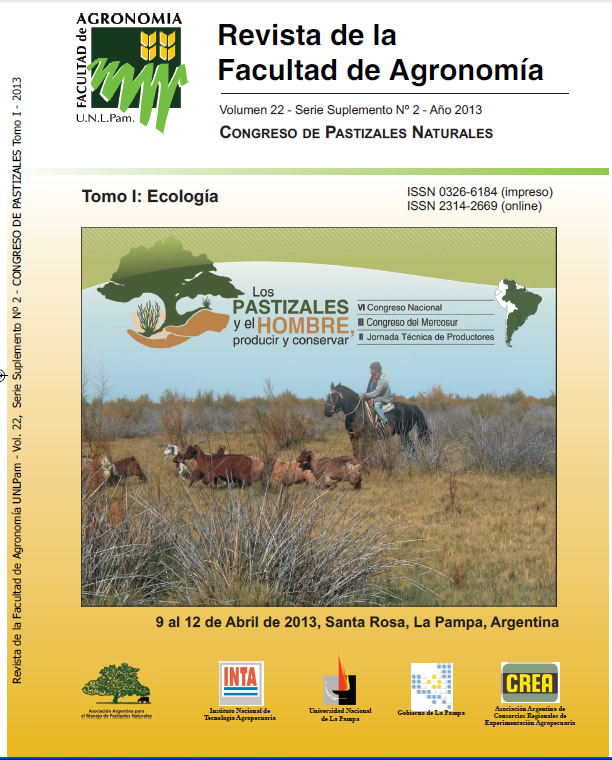Determinación de la correlación entre datos de biomasa obtenidos a campo y ndvi obtenidos por sensores remotos a lo largo del arroyo Chucul (Pcia. Córdoba)
Palabras clave:
Sensores remotos, Biomasa verde, Pastizales naturales, CorrespondenciaResumen
Los valores de biomasa aérea verde (Bv) medidos en el pastizal se relacionaron con los valores de índices de vegetación de diferencia normalizada (NDVI) provenientes de datos satelitales en tres relictos de pastizales naturales en las riveras del arroyo Chucul, desde su nacimiento: sitio 1 (32° 49´21,0``S y 64° 24` 07,0`` W), hasta su desaparición en zona de llanura: sitio 3 (33° 06`25,5``S y 63° 32`49,1``W). Bajo la hipótesis de correspondencia de Bv y datos obtenidos por imágenes, se planteó como objetivo de este trabajo determinar la relación entre datos medidos a campo y datos satelitales en pastizales naturales. Estacionalmente durante el ciclo 2009-2011 se realizó un muestreo al azar con 10 réplicas de 0,25 m2 registrando lista florística. Para determinar Bv se cortó biomasa en cada parcela separando en compartimentos verde y seco y se llevó a estufa hasta peso constante. Para el análisis digital se utilizaron las bandas 3 y 4 de una imagen Landsat 5 TM (Path 228 Row 083), por cada sitio próxima a la fecha de muestreo. Los mayores valores de Biomasa verde se determinaron para el sitio 3, en diciembre de 2011: 189,6 g/m2 y en marzo para los sitios 1 y 2: 105,74 y 115,22 g/m2. Entre todos los valores observados de biomasa y estimados por el NDVI el coeficiente de correlación más alto correspondió al sitio 3 (R=0.50). Los resultados del trabajo para el sitio 3 corroboran en parte la hipótesis planteada, indicando escasamente, en este caso, la aptitud de las imágenes digitales para realizar estudios de seguimiento del estado y de cambios en la vegetación.Descargas
Citas
Asrar G., M. Fuchus, E.T. Kanemasu & J.L. hatfield. 1984. Estimation absorbed photosynthetic radiation and leaf area index from spectral reflectance in wheat. Agron. J. 76: 300-306.
Baret F. & G. Guyot. 1989. Potentials and limits of vegetation indices for LAI and APAR assessment. Remote Sens. Environ. 35: 161-173.
Boyd W. 1986. Correlation of rangelands brush canopy cover with Landsat MSS data. J. Range Manage. 39: 268- 271.
Chen J. 1995. Integrating AVHRR derived NDVI with Ecological Modelling. Middle States Goegrapher. Vol. 28.
Chuvieco E. 1996. Fundamentos de Teledetección Espacial. Eds RIALP.S.A. Madrid, España.
Curran P.J. 1983. Multispectral remote sensing for the estimation of green leaf area index. Philosophical Transactions of the Royal Society of London A. 309: 257-270.
Gerberman A.J., J.A. Cuellar & H.W. Gausman, 1984. Relationship of sorghum canopy variables to reflected infrared radiation for 2 wavelengths and 2 wavebands. Photogramm. Eng. Rem.S. 50: 209-214.
Mársico L. & A. Altesor. 2011. Relación entre la riqueza de especies vegetales y la productividad en pastizales naturales. Ecol. Austral 21: 101-109.
Paruelo J.M., H.E. Epstein, W.K Lauenroth & I.C. Burke. 1997. A NPP estimates from NDVI for the Central Grassland Region of the US. Ecology 78: 953-958.
Prince S.D. 1991. A model of regional primary production for use with coarse resolution satellite data. Int. J.Remote S. 12: 1313-1330.
Pucheta E., E. Ferrero, L. Heil & C. Schneide. 2004. Modelos de regresión para la estimación de la biomasa aérea en un pastizal de montaña de Pampa de Achala (Córdoba, Argentina). Agriscientia 21(1): 23-30.
Pueyo J.M., L. Lacopini, Y. Bonini, J. Fonseca, R. Ludi & R. Grancell. 2003. Productividad del campo natural. Publicaciones. EEA INTA Paraná, Entre Ríos.
Pueyo J.M., L. Lacopini, Y. Bonini, J. Fonseca R. Ludi & R. Grancell. 2005. Productividad del Pastizal Natural. EEA Concepción del Uruguay.
Sánchez Rodríguez E, M.á. Torres Crespo, A. Fernández Palacios Carmona, M. Aguilar Alba, I. Pino Serrato & L. Granado Ruiz. 2000. Comparación del NDVI con el PVI y el SAVI como Indicadores para la Asignación de Modelos de Combustible para la Estimación del Riesgo de Incendios en Andalucía. Tecnologías Geográficas para el Desarrollo Sostenible. Departamento de Geografía. Universidad de Alcalá. pp. 164-174.
Sellers P.J. 1985. Canopy reflectance, photosynthesis, and transpiration. Int. J. Remote S. 6: 1335-1372.
Rueter B. & M. Bertolani 2005. Evaluación de la Productividad, Degradación y Ritmos Bioclimáticos en Ecosistemas áridos del Distrito Central, Mediante la Utilización de Percepción Remota. Nat. Patagón.1: 66-72.
Tucker C.J. 1977. Resolution of grass canopy biomass classes. Photogramm. Eng. Rem. S. 43: 1059-1067.
Descargas
Publicado
Número
Sección
Licencia
La Editorial de la Universidad Nacional de La Pampa (EdUNLPam) exigirá a los/as autores/as la firma del siguiente documento:
La EdUNLPam lleva a cabo la publicación del artículo: (Título del Artículo) en SEMIÁRIDA Rev.Fac.Agron UNLPam ISSN 2362-4337 (impresa) ISSN 2408-4077 (en línea), del cual el/los abajo firmantes son autores de una o más partes. En el mismo acto, el/los autores entregan exclusivamente a la EdUNLPam todos sus derechos protegidos por las leyes de propiedad intelectual que rigen en la Argentina para reproducir, publicar, editar, fijar, comunicar y transmitir públicamente en cualquier formato o medio impreso o electrónico, inclusive internet, el artículo enviado a publicación e incluirlo en índices o bases de datos nacionales e internacionales. A cambio, la EdUNLPam entrega a los autores la autorización para la publicación o reimpresión con ines académicos y educativos en cualquier libro o medio de divulgación, con la sola obligación de citar el artículo original publicado en la EdUNLPam. Cada autor acuerda en que el material provisto a la EdUNLPam es un trabajo original, que no ha sido impreso o publicado en cualquier otro medio con anterioridad y que no vulnera derechos de terceros. El Primer autor tendrá la posibilidad de leer y corregir el artículo ya editado como “prueba de galera”, pero si el autor no devolviera esas correcciones de la prueba de galera dentro del tiempo especificado, el proceso de producción y publicación podrá proseguir sin la aprobación del autor. El/los autor/es no recibirán compensación monetaria de la EdUNLPam por el uso del material contenido en este artículo y asumen la responsabilidad de las opiniones vertidas en él.






.png)



22.png)


.jpg)




.jpg)
10.png)



